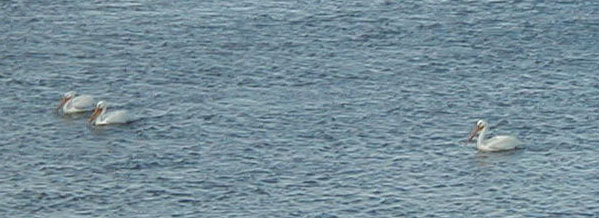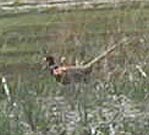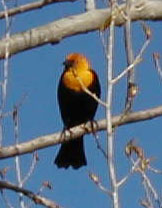
Bird List
Pied-billed Grebe (Podilymbus podiceps) A medium sized duck found in both fresh and salt water areas. Dark-brown to black body with white bill that has a black, vertical stripe.
Western Grebe (Aechmophorus occidentalis) Similar to the Pied-billed but with a narrower bill that lacks the stripe.
American White Pelican (Pelecanus erythrorhynchos) A very large white bird with large orange bill, seen in coastal regions and freshwater marshes. Adult males have raised plate midway along upper mandible.

Double-crested Cormorant (Phalacrocorax auritus) A fairly large water bird that is widespread in both freshwater and marine habitats. Body is blackish with iridescent green or purple gloss above. Throat patch is yellow/orange.
Great Blue Heron (Ardea herodias) Americas largest heron. Very tall and mostly medium gray body with narrow plumes over back and breast. Seen in freshwater habitats, mudflats and salt marshes.
Great Egret (Ardea alba)
A very large white heron, more slender in body that the
Great Blue Heron. Bill is yellow to orange and legs and feet are
black.
White-faced Ibis (Plegadis chihi)
A medium to large wading bird with a long, down-curved
bill. Inhabits salt and freshwater, marshes, lakes and mudflats.
Glossy brownish-green above and below with maroon neck and face.
White feathers surround facial patch.
Turkey Vulture (Cathartes aura)
A medium to large sized bird. Eagle-like with dark
brown body with small, unfeathered red head and white-tipped bill.
Often seen soaring over open country and woodlands.
Canada Goose (Branta canadensis) Very large. The most common goose of North America. Frequents several environments from corn fields to rivers and marshes. Recognizable by musical honking call of birds in v-shaped flight.
Trumpeter Swan (Olor buccinator) A very large, long-necked swan with white plumage. Bill, legs and feet are all black. Males and females are similar. Nests on tundra of Far North, migrates tremendous distances to winter on marshy lakes and coastal bays.
Mallard (Anas platyrhynchos) The largest dabbling duck. Found in ponds, marshes, streams, city parks and other fresh and saltwater habitats. Male distinguished by all green head, yellow bill, white collar and chestnut breast.
Cinnamon Teal (Anas cyanoptera) A smallish duck of marshes and wetland, especially in arid regions. Adult males have a deep cinnamon-red head, breast, belly and flanks, with a red eye. Both male and female have long, dark, somewhat spoon-like bill.
Northern Pintail (Anas acuta) A graceful, slender duck. Abundant through most of North America, particularly in the West in winter. Adult males have brown head, slender white neck and breast with thin, vertical white stripe extending up to side of head. Body grayish overall. Bill blue, tail long.
Northern Shoveler (Anas clypeata)
A colorful, medium-sized duck. Noticed chiefly
for their remarkable, spatulate black bill, which is long that the head.
Males have rust-colored sides and belly, white breast. Found in fresh
and saltwater marshes, lakes and ponds.
Gadwall (Anas strepera)
A common, rather plain, brownish dabbling duck of lakes,
ponds, fresh and saltwater marshes. In all plumages, best field mark
is white speculum, unique to the Gadwall.
Western Tanager (Piranga ludoviciana)
A sparrow-sized, quiet bird, found in open coniferous
forest in summer. Adult males are bright yellow with reddish-orange
face. Back and tail are black and wings are black with two wing bars,
the upper one yellow and the lower one white.
Bald Eagle- (Haliaeetus Leucocephalus)- 31, wingspan: 71-89 Large bird with a dark body and a white head and tail. If immature it will have white armpits and white molting on wings. Is found along coasts, lakes, and large rivers in most parts of North America. It eats mostly fish, other birds and occasionally small mammals.
California Quail- (Callipepla Californica)- 10 Distinguishable by the black plume on their forehead, which both sexes have, they also have a scaled appearance on their belly. The difference between the males and females is the males chin is black and the female is a lighter brown. They live in open woodlands or shrubby areas near water and eat weeds, grasses, grain and insects.
American Avocet- (Recurvirostra americana)-18, have a long, thin upturned bill and black on their wings and back with a white body. The females have a shorter more curved beak. They have reddish brown heads during most of the year, but in the winter their heads turn gray. In the summer they live on shallow inland lakes and in the winter they live on coastal flats. They usually feed in flocks and eat crustaceans, fish, aquatic insects, and seeds.
Red Tailed Hawk- (Buteo Jamaicensis)- 19, wingspan: 47-56 In flight an adult would have long broad wings, held in a shallow v, with a reddish upper tail. They have dark markings on the inner front edge of the underwing and a white chest usually with a darker bellyband across it. They can live in a variety of open habitats and our found in all parts of North America. They feed on small mammals, birds, and reptiles.
Sandhill Crane- ( Grus Canadensis)- 45 Tall Grey, heron like bird with a dark red patch on their foreheads and black bills. In the summer they live in prairies and tundras and during the winter they roost on shallow water and feed in agricultural fields. They feed by picking or probing with bill and they eat seeds, agricultural grains, and small animals.
Killdeer- (Charadrius Vociferous)- 10 Is the only North American Plover to have two neck rings, which are black. He has a brown back and a white belly. He also has a light reddish rump that can easily be seen when the bird flies. They live in open ground with gravel or short grass and eat mostly insects.
Sage Grouse- ( Centrocercus urophasianus)- 31 A very large grouse with a pointed tail and a black belly. The males have a black chin with a big white breast, which can be inflated with air when he is on display. The females have a light brown chin and a brown breast. They live in only sagebrush and eat sagebrush leaves, weed seeds, flowers and buds.
American Coot- ( Fulica americana)- 15 Ducklike, dark-slate colored birds with a white bill. They also have a partial ring around the tip of the bill. In the summer they live in marshy lakes and in the winter along the coast. They eat seeds, leaves, roots, and small aquatic animals.
Northern Harrier- (Circus cyaneus)- 18, wingspan: 38-48 In flight they will have long slender wings held in a V, with a long tail and a rectangular white patch on rump. The males are gray on their tops and white on their bellys. The females are larger then the males and have brown above and are streaked on their belly. They live in open fields, grasslands, prairies, and marshes. They feed on mice, rats, birds, snakes, frogs, and other small mammals.
Redhead- ( Aythya americana)- 20 Both sexes have short bluish bills with black tips and steep rounded foreheads. The males have a reddish head, with a black breasts and a grayish body. Females are plainer with a light brown body and a darker brown back and wings. They also have a cream-colored eye ring around their eye. They live in ponds, lakes and bays and eat aquatic vegetation along with insects, larvae, mollusks and crustaceans.
Ring -necked Pheasant- (Phasianus colchicus)- 33 A large chickenlike bird with a long pointed tail. Males will have a white neck-ring, with a green head and neck, and red around his eyes and on his checks. The body is a mixture of iridescent greens, browns and golds. Females are a rich brown color with dark markings on wings and back. They live on farmland with wooded edges and hedgerows and eat waste grain, weed seeds, acorns, berries, and insects.

Black-necked Stilt- ( Himantopus mexicanus)- 14 They have black on the top part of their body and white on the bottom part, with long pink legs. The differences between males and females is on the males the black will stay black and the females black areas will fade and turn dark brown by the end of the summer. They live in shallow water in marshes, ditches, ponds, salt ponds, or fields and they eat larvae, nymphs, insects, small fish and seeds.
American Wigeon- ( Anas americana)- 21 The males have a white forehead and crown, with a gray head and an iridescent green patch through the eye. They also have a white patch right before their black tail. The females have brownish sides and a grayish head and neck with a dark eyespot and a light gray bill with a black tip. In summer they live on lakes and marshes and in the winter they live on wet meadows, lakes and protected coastal waters. They feed on the steams, leaves and buds of aquatic plants such as Pondweeds, Water milfoil, and Wigeon grass.
Ferruginous Hawk- ( Buteo regalis)- 23, wingspan: 53-60 Has a very large white body and white underwings, with chestnut colored molting on wing linings, that along with their dark feathered legs form a V on its underside. They live in arid open land and grasslands and eat mostly medium-sized mammals, reptiles, and insects.
Rough-legged Hawk- (Buteo lagopus)- 21, wingspan: 48-56 There are light morph and dark morph variation of this Hawk. The light morphs have black rectangular patches on the first bend in the wing and a white tail, with a wide dark band at the tip. Males have a darker chest then belly and females have a darker belly then chest. The dark morphs have darker bodies and wing coverts, and silvery barred flight feathers with dark trailing edges. The males have a black tail with 3-4 narrow white bands, where the female has a silvery tail with a dark band at the tip. In the summer they live at the arctic tree line, and in the winter in open county. They eat mostly voles, and lemmings.
Canvasback- ( Aythya valisineria)- 21 A long billed duck with a long sloping forehead. The males have a reddish brown head, black breast and a white body with a black bill and tail. The females have a grayish body with a brown head and neck. They also have a long black bill with a long sloping forehead. In the summer they live on prairie lakes and marshes and in the winter on lakes and sheltered coastal waters. They dive up to 30 ft to get roots, buds, and tubers of aquatic plants like pondweed and celery. They also eat insects, small fish, and crustaceans.
Ruddy Duck- ( Oxyura jamaicensis)- 16 A small stocky duck with a broad bill and a stiff tail that is often held straight up. In the summer males have a reddish brown body with a black head and white cheeks and they have a light blue bill. The females stay the same all year and are brown with a head that is two-toned, having a darker crown but with a lighter check with a line through it. In the winter males are similar to females because they get browner, but they still have a darker head and a white cheek. In the summer they live in open lakes and in the winter they also live along the coast. They dive and feed on aquatic plants, crustaceans, and insects.
Willet- (Catoptrophorus semipalmatus) - The Willet is grayish-brown, (colors vary with the seasons) has a long, straight, rather thick bill, and long, thin, gray legs.
Common Snipe- (Capella gallinago) - The Snipe is a commonly seen medium-sized shore bird with short legs and a long beak.
Caspian Tern - The Caspian Tern is gray above and white below, with black markings on the head. It has webbed feet, and a slender pointed beak.
Mourning Dove- (Zenaida macroura) - The Mourning Dove is grayish-iridescent pink in color with black dots on its wings. It is a sleek pigeon-like bird with a long pointed tail, small head, and orange colored feet.
Rufous Hummingbird- (Salasphorus rufus) - The Rufous is a very small orange-brown colored bird, except for its bright iridescent orange-red throat (that is mostly visible in flight), and the white band under its throat.
Belted Kingfisher- (Megaceryel alcyon) - The Kingfisher is a crested blue and white bird, with a large head, a long, strong beak, short tail and short legs.
Northern Flicker- (Colaptes auratus) - The Flicker has a tan colored breast with black spots on it, a thick black necklace, small red patches on the sides of its cheeks, and a thick, pointy bill.
Says Phoebe- (Sayornis phoebe) - This is a medium
size, fly catching bird that is grayish-olive in color with a slightly
paler color below.
Western Kingbird (Tyrannus verticalis): The Kingbird
is mostly gray in color except for its bright yellow under belly. It has
as short bill, and a square tipped tail with thin white edges.
Loggerhead Shrike- (Lanius ludovicianus): The Shrike is gray above and white below, with black and white on the wings and tail, and they have a mask across their eyes. They have large heads, with stout, hooked beaks, strong legs, and long tails.
Black-billed Magpie- (Pica pica): The Magpie is black and white, (the black sometimes looking iridescent green), it has a thick black bill and a very long tail.
American Crow- (Corvus brachyrhynchos): The Crow is a very commonly seen, all black bird, with a thick black beak. Not to be confused with the Raven which is a larger bird of similar characteristics.
Common Raven- (Corvus corax): The Raven is a very large all black bird. (see Crow)
Tree Swallow- (Tachycineta bicolor): The Tree swallow has a beautiful iridescent blue-teal color on its back and head and a pure white throat and belly. They have very small black beaks.
Cliff Swallow- (Petrochelidon pyrrhonota): The Cliff swallow is mostly brown with hints of iridescent green on its back. It is thought to be smaller than the other two verities mentioned.
Barn Swallow- (Hirundo rustica): The Barn swallow has a iridescent blue back and head with a rusty-brown throat and small patch above its beak. It also has a cream-rust colored belly and a distinctive forked tail.
Marsh Wren- (Cistothorus palustris) (5) Brown is main color with white stripe continuing down back. Common in reedy marshes and cattail swamps. Makes his presence known with his high-pitch call and fluttery behavior.
Ruby-crowned Kinglet- (Regulus calendula) (4.5) Small bird with yellow streaks mixed in with black and white on the wings. Has a yellow tint to the chest and a ruby colored patch on the males head. Common in woodlands and thickets.
Western Blubird- (Sialia Mexicana) (7) On males, chest is chestnut color while the shoulders, throat, and back are a deep blue. Common in woodlands, farmlands, and orchards. Nests in holes in trees, posts, or in nest boxes.
American Robin- (Turdus migratorius) (10) Brown on top with chestnut color on the underside. Yellow beak and very prominent black eye with white ring. Very common pretty much everywhere in North America. Commonly seen on lawns or dirt with heads bobbing around looking for earthworms and insects.
European Starling- (Sturnus Vulgaris) (8.5) Black in color with a glossy coating, some white tips on their feathers, giving them a speckled appearance. A Eurasian species introduced in New York around 1890, soon spreading throughout the continent. Often successfully competes with other Native Species for nest holes.
Yellow Warbler- (Dendroica petechia) (5) Plump with short tail and yellow in color with light streaks on chest. Mostly found in wet habitats, especially willows and alders. Prefers open woodlands, gardens, and orchards as well.
Yellow-rumped Warbler- (Dendroica coronata) (5.5) Yellow on throat, head, and rump. Black on chest and back with streaks of white. Same basic shape as yellow warbler. Abundant in carniferous forests.
Common Yellowthroat- (geothlypis trichas) (5) Broad black mask is bordered with grey or white. Yellow starts after the mask and continues along the chest to the rear. Brown on top. Common in grassy fields, shrubs, and marshes.
Sage Sparrow- (Amphispiza belli) (6.25) White eye ring, brown on back with white on belly and chest. Dark central breast spot. Favor alkaline flats in sagebrush and saltbrush.
Song Sparrow-(Melopiza melodia) (5.75-7.5) Long rounded tail. Greyish eyebrow and crown with white streaks down chest. Brown on back, top, and chest. Generally common in brushy areas, especially dense streamside thickets.
Red-winged Blackbird- (Agelaius Phoeniceus) (8.75) Glossy black male has red shoulder patches that are broadly tipped with light-yellow. Abundant in thick vegetation of freshwater marshes, sloughs, dry fields. Very unique call also.
Yellow-headed Blackbird- (Xanthocephalus xanthocephalus)
(9.5) Adult males have yellow heads and breast. White wing bars
contrast sharply with black body. Very bright in sunlight and yellow
spot on rear when bending over. Common throughout most of range.
Prefers freshwater marshes or reedy lakes.

Western Meadowlark- (Sturnella neglecta) (9.5) Large V shaped breastband on yellow underparts is highly visable. Black and white streaks on head with spots on sides of belly and chest. Very unique call that can be heard from far away. Usually seen in high places like phone poles or powerlines. Prefer open, elevated areas.
Brewers Blackbird- (euphagus cyanocephalus) (9) Male has yellow eyes and black body annually with a purplish gloss on head and neck. Greenish gloss on body and wings. Common in open habitats.
Brown-headed Cowbird- (Mulothrus ater) (7.5) Males are brown-headed that contrasts with the mettalic-green/black body. Common and found in woodlands, farmland, and suburbs. All cowbirds lay their eggs in nests of other species.
American Goldfinch- (Carduelis tristis) (5) Adult male is yellow with a black cap. Black wings have white bars with yellow shoulder patch and the tail is black and white. Common and found in weedy fields, open second-growth woodlands, and especially in thistles and sunflowers.
House Sparrow- (Passer domesticus) (6.25) Grey
crown, chestnut eye stripe, black bib and bill. Abundant and aggressive.
Strive in populated areas and often nest in rooftops and buildings.